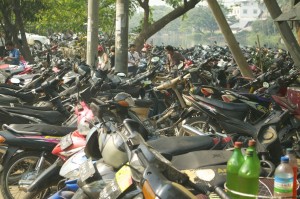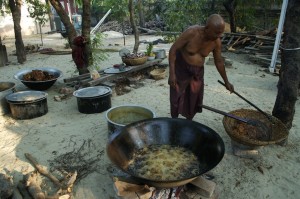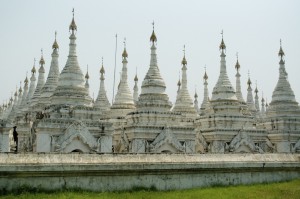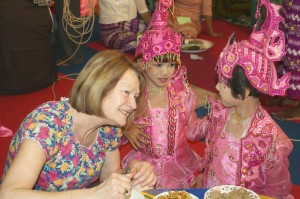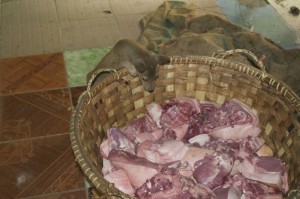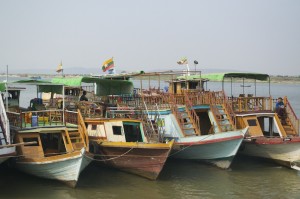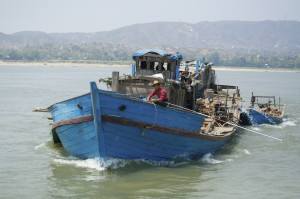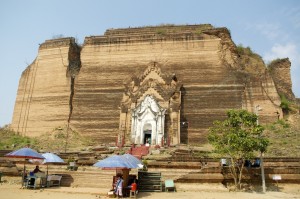A twenty two minute flight took us from Bagan to Mandalay, a place that has conjured up all sorts of images in the mind going as far back as my childhood. It was one of those places that cropped up in geography. Kipling wrote about it and, of course, Bob Hope and Bing Crosby travelled the road to Mandalay. As we drove into the city all those romantic images of Shangrila were dispelled in the chaos of the roads, the slightly ramshackle approach to building and the general scruffiness of the streets. They weren’t Kathmandu dirty but they were not as well cared for as some. It was particularly noticeable that the pavements were more hazardous and the allowance of thousands of motorbikes on the roads meant that they seemed much more dangerous, as much for pedestrians as anybody else.
Our first visit was to the Jade Market. I was expecting the usual demonstration workshop and a sale room. How wrong was I? I should have realised before I got there as there were thousands of motorbikes parked several deep each side of the road. I remember thinking as I walked past them, “How do they know which bike is theirs when there are so many that look alike?”
The entrance to the Jade Market revealed all. The cacophony of noise from thousands of voices haggling, bartering and making a deal was deafening. Most of the traders were Chinese who seem to have captured the trade in jade. We were hit by a wall of sound.
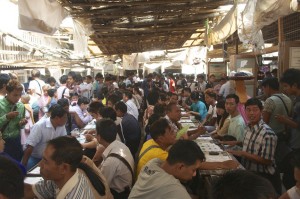 The market was made up of a series of alleyways in a grid system. Each alleyway was heaving with people, mostly men, although there were sections where women worked. Very few women roamed the alleys apart from nuns who were going around collecting alms. Some were young children, far to young to be in this sort of environment. On either side of the alleyways, and sometimes down the middle if width allowed, buyers sat at little desks armed with a small torch which they shone at the jade to check its quality. If an acceptable price was offered a deal would be sealed, if not the seller would move on to another buyer until he got something close to satisfaction. It was difficult to move around but nobody minded us being there even though they knew we were not there to buy or trade. The women tended to have trays at their little desks with small polished pieces if jade in little clusters according to size or quality. It was like a stock exchange. By lunch time things would begin to slow down and by the afternoon the market would fall silent and hopefully everybody will have found their motorbike and gone home.
The market was made up of a series of alleyways in a grid system. Each alleyway was heaving with people, mostly men, although there were sections where women worked. Very few women roamed the alleys apart from nuns who were going around collecting alms. Some were young children, far to young to be in this sort of environment. On either side of the alleyways, and sometimes down the middle if width allowed, buyers sat at little desks armed with a small torch which they shone at the jade to check its quality. If an acceptable price was offered a deal would be sealed, if not the seller would move on to another buyer until he got something close to satisfaction. It was difficult to move around but nobody minded us being there even though they knew we were not there to buy or trade. The women tended to have trays at their little desks with small polished pieces if jade in little clusters according to size or quality. It was like a stock exchange. By lunch time things would begin to slow down and by the afternoon the market would fall silent and hopefully everybody will have found their motorbike and gone home.
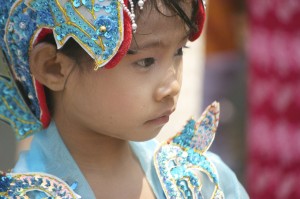 As we drove further into Mandalay there were a number of motor processions on the streets. The vehicles were generally pick up trucks with plastic chairs on the truck carrying ornately dressed children and adults. They were all heading towards the foot of Mandalay Hill as part of the initiation ceremony for children, boys and girls, entering the monastery or nunnery. For some children this will be a life changing event as they leave behind their family and home to live in a frugal environment. For some they may spend years, if not the rest of their lives in service to Buddha. Others may only be there for a matter of days or weeks. If they are not happy they can leave at any time. However, the education that those who stay for a number of years will benefit them in later life whether they remain a monk or nun.
As we drove further into Mandalay there were a number of motor processions on the streets. The vehicles were generally pick up trucks with plastic chairs on the truck carrying ornately dressed children and adults. They were all heading towards the foot of Mandalay Hill as part of the initiation ceremony for children, boys and girls, entering the monastery or nunnery. For some children this will be a life changing event as they leave behind their family and home to live in a frugal environment. For some they may spend years, if not the rest of their lives in service to Buddha. Others may only be there for a matter of days or weeks. If they are not happy they can leave at any time. However, the education that those who stay for a number of years will benefit them in later life whether they remain a monk or nun.
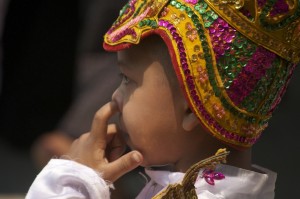 Driving to the foot of Mandalay Hill we joined the throng. Having processed, they were now going into the temple with offerings and then having a picnic lunch anywhere where they could find some space. There was very much a party atmosphere and everybody greeted us with happy, smiling faces. Over and above the noise of the human throng loud music played from vehicles stacked with speakers. It was great to mingle freely, clicking away, and I could have stayed there much longer but a couple of small trucks were booked to take us to the top of Mandalay Hill and the temple. The drive took us uncomfortably up a series of hairpin bends, at the top of which we gratefully disgorged ourselves from the trucks.
Driving to the foot of Mandalay Hill we joined the throng. Having processed, they were now going into the temple with offerings and then having a picnic lunch anywhere where they could find some space. There was very much a party atmosphere and everybody greeted us with happy, smiling faces. Over and above the noise of the human throng loud music played from vehicles stacked with speakers. It was great to mingle freely, clicking away, and I could have stayed there much longer but a couple of small trucks were booked to take us to the top of Mandalay Hill and the temple. The drive took us uncomfortably up a series of hairpin bends, at the top of which we gratefully disgorged ourselves from the trucks.
From the top we had views over the whole of Mandalay, although the heat was making it a bit hazy.
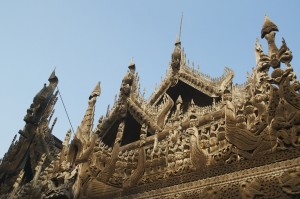 In the late afternoon we went first to see the wooden palace of Shwe Nandaw Kyaung. The palace was originally built in Amarapura, the then capital under the ruler King Mindon. The original building was heavily gilded with gold. The wood carving is fantastic in its own right but when it was golden it must have been a spectacle. When Mindon died in 1878 his son, Thibaw, became king. He moved the capital from Amarapura to Mandalay. In the process of moving Thibaw built a new palace complex in Mandalay behind a high walk surrounded by a wide moat. Each side was two kilometres in length. It was a relatively easy process as not a single nail was used. It was all held together with joints fixed with wooden pegs. I haven’t quite understood when and why it was moved to its present position but it is a good thing that it was as the whole of the palace complex, with the exception of the watch tower, was destroyed by the Japanese in 1945.
In the late afternoon we went first to see the wooden palace of Shwe Nandaw Kyaung. The palace was originally built in Amarapura, the then capital under the ruler King Mindon. The original building was heavily gilded with gold. The wood carving is fantastic in its own right but when it was golden it must have been a spectacle. When Mindon died in 1878 his son, Thibaw, became king. He moved the capital from Amarapura to Mandalay. In the process of moving Thibaw built a new palace complex in Mandalay behind a high walk surrounded by a wide moat. Each side was two kilometres in length. It was a relatively easy process as not a single nail was used. It was all held together with joints fixed with wooden pegs. I haven’t quite understood when and why it was moved to its present position but it is a good thing that it was as the whole of the palace complex, with the exception of the watch tower, was destroyed by the Japanese in 1945.
A film crew was at the palace filming a story about an American of Burmese descent returns to Myanmar to trace his roots.
En route to see the world’a largest book we came across activity in a garden where large quantities of food were being prepared for a feast the next day, part of one of the initiation ceremonies we had been watching earlier in the day. Having processed today they have large family parties the next day provided by a sponsor, usually a relatively rich family member. It was fascinating to watch the men stripped to the waist, their bodies glistening in the dual heat of the day and the fires. Huge woks and cooking pots were bubbling away as they deep fried huge quantities of fish, chicken and pork. Another ingenious stove was cooking a mix if eggs and sesame paste until it was thick enough to put in flat pans to set. Three holes in a line had been dug in the dry earth. The middle hole was where the cooking pot sat above a fire fed with sticks from the first hole. The third hole allowed the flames to escape and not over cook or burn the food. Brilliant! Again they were happy to show us everything.
From there we continued to see the largest book in the world, the 729 double sided stone tablets with the entire works of the Buddhist canon recorded on them. Each tablet is housed in its own shrine surrounding the Kuthodore Pagoda. It was an impressive sight looking along these rows if white structures.
In the evening we visited a small local restaurant where they produced an “all you can eat” buffet for as little as 4000 Kyats, about £2.50.
The following morning, on our way to Amarapura and Mahagandayone Monastery to watch two thousand monks process into lunch, Uza spotted a gathering for the second day of an initiation ceremony. Music was playing and there were lots of children dressed in their vivid and ornate initiation costumes. We were warmly invited to join the ceremony and as we sourced the hub if the noise we came across a large room where people were sitting on the floor at low tables eating a considerable meal of rice, vegetables, fish and various meats, as we had seen cooking the day before for another ceremony. People beckoned us to sit down and join them and as soon as we did a plate was thrust in front of us, a ladle of rice put upon it and an invitation to tuck into many of the succulent dishes on offer.
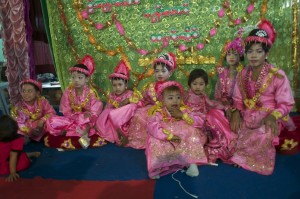 On a small stage the boys being inducted sat displaying a mixture of emotions. They were all wearing pink costumes and make up, both of which made them look very feminine. Although we could not use language as a means if communication, smiles, gestures and body language said a great deal. I couldn’t help but wonder how we would react if a group of fifteen strangers gate crashed our party.
On a small stage the boys being inducted sat displaying a mixture of emotions. They were all wearing pink costumes and make up, both of which made them look very feminine. Although we could not use language as a means if communication, smiles, gestures and body language said a great deal. I couldn’t help but wonder how we would react if a group of fifteen strangers gate crashed our party.
Out in the yard a number of giant woks and saucepans kept the supply of food constantly refreshed as more people arrived. We could have stayed there much longer and we would certainly have been welcome but we had to move on. It would have been interesting to stay for the ceremonial head shaving which was due to take place at midday.
Moving on we arrived at Mahagandayone Monastery in time to have a look around to see something of their lifestyle before watching their lunch procession which started at 10.15. The kitchens were producing food on an industrial scale with wood burning pits and pots bigger than anything we had seen. One pot full of pieces of pork, probably from a number of pigs, waiting to be cooked was providing interest to a small puppy who could look into it but not reach any of the succulent pieces.
Before the allotted time some of the younger monks began to line up in silence trying to ignore the increasing number if cameras lining the route. Tourists vied for the best spot, hoping for an uninterrupted view. An electronic clock illuminated the time and at 10.15 a bell chimed and the procession moved forward in somber silence as the monks contemplated their lunch. It felt a little as those we were intruding but it was such a spectacle that it was something not to be missed.
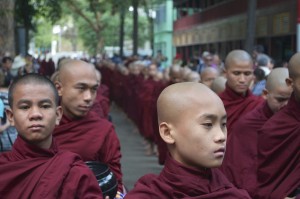 The monks came in all shapes and sizes and it was particularly noticeable,with so many shaved heads, how varied the shape of the human head can be.
The monks came in all shapes and sizes and it was particularly noticeable,with so many shaved heads, how varied the shape of the human head can be.
From within the dining hall chanting could be heard. Remarkably, monks were beginning to leave the dining room before some had finished processing. They do not eat all of their lunch but save some, knowing they have until midday to finish it, trying to spin it out, knowing that there will be nothing more until the next day.
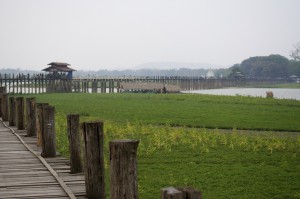 From the monastery it was a short walk down to the Lake Taungthaman to see the world’a longest teak bridge, U Bein Bridge. There were two villages on either side of the lake. The village chief of one used to row across the lake to visit the girls on the other side who were reputedly prettier. However, this took time and energy so he appealed to the king to allow him to build a bridge. The king gave permission on the understanding that it allowed free passage for all villagers on both sides of the lake. So the U Bein bridge was built using 1200 old teak piles sunk into the mud supporting a wide teak walkway. At 1.2km long, it is a remarkable sight. Along the way there are a number of sheltering areas which are wider than the rest of the bridge. These are under canopies which today are used by stallholders selling all sorts of tat and extremely orange cooked crabs brought up from the lake. The most bizarre is a fortune teller.
From the monastery it was a short walk down to the Lake Taungthaman to see the world’a longest teak bridge, U Bein Bridge. There were two villages on either side of the lake. The village chief of one used to row across the lake to visit the girls on the other side who were reputedly prettier. However, this took time and energy so he appealed to the king to allow him to build a bridge. The king gave permission on the understanding that it allowed free passage for all villagers on both sides of the lake. So the U Bein bridge was built using 1200 old teak piles sunk into the mud supporting a wide teak walkway. At 1.2km long, it is a remarkable sight. Along the way there are a number of sheltering areas which are wider than the rest of the bridge. These are under canopies which today are used by stallholders selling all sorts of tat and extremely orange cooked crabs brought up from the lake. The most bizarre is a fortune teller.
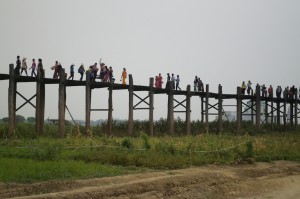 Walking from one end to the other and back it was noticeable that it is used a lot by young local people who socialise, take lots of photos on their mobile phones etc. with so many people walking on the bridge it has a noticeable wobble and I can imagine a news report one day telling of the collapse of U Bein Bridge. Some of the supports suggest that day will not be far away. It is a remarkable structure and well worth the visit. There are boats on the lake. A boatman will take you out on the water and give you a different perspective of the bridge and a closer look at the fishermen and the water birds that live and feed on the lake.
Walking from one end to the other and back it was noticeable that it is used a lot by young local people who socialise, take lots of photos on their mobile phones etc. with so many people walking on the bridge it has a noticeable wobble and I can imagine a news report one day telling of the collapse of U Bein Bridge. Some of the supports suggest that day will not be far away. It is a remarkable structure and well worth the visit. There are boats on the lake. A boatman will take you out on the water and give you a different perspective of the bridge and a closer look at the fishermen and the water birds that live and feed on the lake.
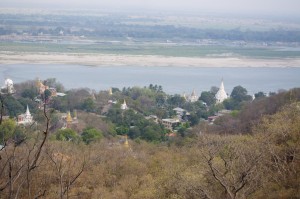 Having walked the bridge I went down to water level to photograph the bridge in silhouette before returning to Mandalay via Sagaing where we visited a nunnery to see how they lived, and going to the top of Sagaing Hill. From the top we looked down on the plain below and the Ayeyarwady River. I was already looking forward to travelling on the river the next day and bringing to life some of those rather boring geography lessons that I had to endure as a child.
Having walked the bridge I went down to water level to photograph the bridge in silhouette before returning to Mandalay via Sagaing where we visited a nunnery to see how they lived, and going to the top of Sagaing Hill. From the top we looked down on the plain below and the Ayeyarwady River. I was already looking forward to travelling on the river the next day and bringing to life some of those rather boring geography lessons that I had to endure as a child.
Back in Mandalay we visited the old palace within its walls. A large part of the area within is taken up by an army barracks but where the palace had been before it was destroyed they have build a replica. Instead of gilding it with gold leaf they have simply painted those areas gold. It gives an impression but it is not worth spending a great deal of time there.
When I was at school the Ayeyarwady River often came up in geography lessons. It is one of those rivers that has a mystical air about it. It is 2000km long and all but 400 of those kilometres is navigable. Hence, at Mandalay the river is busy. On our final day in Mandalay we were taking a boat up river to Mingun. The journey took about an hour as we chugged up river. There was so much to see. There were boats of all shapes and sizes carrying tourists, teak, coal, vegetables, sand and probably much more. Rafts of bamboo were being towed to a bamboo market on one of the banks. They too provided interest with men cutting away at the loose sand banks to gather building material which they would shovel into small boats and take away. Fishermen cast their nets or set traps. On one sand bank makeshift bamboo shelters were being erected for a forthcoming party.
Many of the boats had men sitting at the bow with a long stick which they would put into the water every so often to test the depth. When it became threateningly shallow a rapid change of course would be made. The river is so large and carrying so much silt in it that the sandbanks and channels under the surface are constantly changing. It was a fascinating journey and brought to life all those dull geography lessons.
Most of the cargo boats travelling on the river would not get a license to sail in the west. They seem to be held together by nails in such a fashion that they look very Heath Robinson. Repairs have been done and bit added on to make them look very rough and ready. The engines are noisy and often belch out noxious fumes. But despite everything, I think they are wonderful. They have character and I could watch them all day.
Arriving a Mingun we went ashore to look at the unfinished pagoda. It had been guarded by two enormous lions but they, like the unfinished pagoda are ruins. It is hard to imagine what they would have looked like but they were the height of a three storey house when they were complete. The reason it is unfinished is because a massive earthquake did its best to destroy it in 1838. By then only the bottom third had been built. The desire was to build the biggest pagoda of all. The base that remains is a huge cube of bricks rising 50m. Huge cracks from the quake have split into it and large blocks have collapsed.
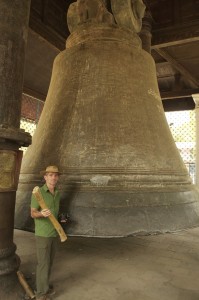 A short distance away is a shrine that houses the largest working bell in the world. There is a larger bell in Russia but it is broken. Weighing 87 tons, it is suspended from a huge beam. It is difficult to imagine why it was necessary to have such a big bell. I guess if you are wanting to build the biggest pagoda, you naturally want to supply it with the biggest bell. What engineering difficulties they would have had to face had the pagoda been finished would have been interesting, particularly when they would have had very limited mechanical aid. Man has found solutions to such problems for thousands of years, so I expect it would have been successful if they had been able to finish the job. You can crawl into it and try to decipher all the graffiti that has been written on it over a great many years. The sound is not as deafening as I expected but I suspect that if it was hit with something more substantial than a piece of wood it might well be.
A short distance away is a shrine that houses the largest working bell in the world. There is a larger bell in Russia but it is broken. Weighing 87 tons, it is suspended from a huge beam. It is difficult to imagine why it was necessary to have such a big bell. I guess if you are wanting to build the biggest pagoda, you naturally want to supply it with the biggest bell. What engineering difficulties they would have had to face had the pagoda been finished would have been interesting, particularly when they would have had very limited mechanical aid. Man has found solutions to such problems for thousands of years, so I expect it would have been successful if they had been able to finish the job. You can crawl into it and try to decipher all the graffiti that has been written on it over a great many years. The sound is not as deafening as I expected but I suspect that if it was hit with something more substantial than a piece of wood it might well be.
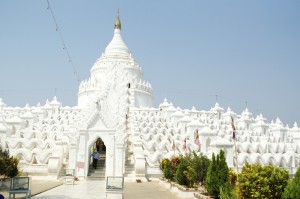 Just beyond that there is a pagoda that us unlike all others. It is blindingly white. There are seven tiers with wavy edges representing the seven oceans. Above is a dome with a small temple with two Buddhas, one white and one gold. The gold one sits in front of the white one. The gold one is a relatively new one because somebody cut off and stole the head of the original white one. It would be sacrilege to destroy the white one further so they placed the gold one in front. Since, the stolen head has been found and returned to its rightful place. Hence two Buddhas.
Just beyond that there is a pagoda that us unlike all others. It is blindingly white. There are seven tiers with wavy edges representing the seven oceans. Above is a dome with a small temple with two Buddhas, one white and one gold. The gold one sits in front of the white one. The gold one is a relatively new one because somebody cut off and stole the head of the original white one. It would be sacrilege to destroy the white one further so they placed the gold one in front. Since, the stolen head has been found and returned to its rightful place. Hence two Buddhas.
The boat took us back down stream and dropped us off at a riverside restaurant for lunch.
After lunch we visited a gold leaf workshop to see it being made. How the men do that all day and endure the constant noise of hammering is unbelievable.
The Mandalay City Hotel where we have been staying is right in the heart of the city. Access is through an arch into a courtyard space and an entrance that looks quite impressive. The lobby is airy and air conditioned but doesn’t have enough seats for all those wanting to use the wifi. It is the only place in the hotel that wifi works and that is not always the case. There is no lift. The rooms are adequately sized but a little tired. In my room only one light switch worked all the lights and there was no choice, it was all or nothing. Not all the sockets worked. The aspect of the rooms varied a great deal. Some looked out on to the small garden and pool area, and presumably adjacent buildings while on the other side you looked out on the drab buildings and a mosque which called you to prayer at five in the morning. I never really opened my curtains. The minibar was empty.
However, the food was excellent, both at breakfast time and in the evening and the staff were excellently trained and deserving of their tip.

